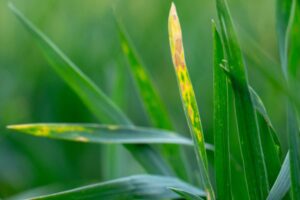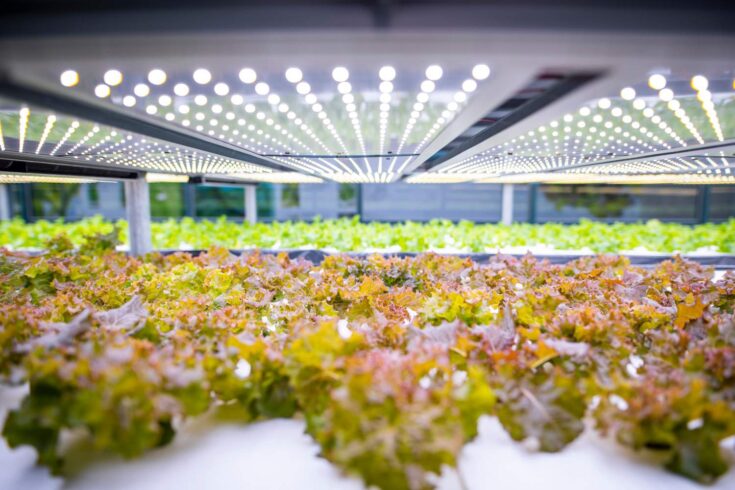Phil Bicknell of fellow UK agri-tech, Centre for Innovation Excellence in Livestock (CIEL), recently penned a blog that explored what’s on the horizon for agri-tech, following the Oxford Farming Conference.
I’d like to use this as an opportunity to build upon this by:
- discussing what is beyond that horizon
- exploring the important role of today’s research in driving tomorrow’s future innovation in agriculture.
Big challenges require big solutions
As Innovate UK, our main sponsor, highlights in its recently launched plan for action, globally, agriculture faces the huge challenge of producing:
- food
- clothing
- fuel
- essential products for a growing population.
Additionally, this has to balance with the need to use less land and fewer resources, whilst proactively striving for sustainability to protect the environment.

Wheat shoots with septoria. Credit: MaYcaL, iStock, Getty Images Plus via Getty Images
This is alongside a background of rapidly changing global markets and societal needs.
Tackling these big problems will require big solutions, pulling together large numbers of individuals from across:
- research
- innovation
- business
- society.
Collaborative working and effective delivery
The question is, how do we find and connect these groups to enable collaborative working and effective delivery?
Often the answer is that it’s an organic meeting of minds, or as a result of sudden impactful events, such as we’ve seen in the global pandemic.
But is there a way in which we can expedite these mechanisms to better harness this collective knowledge and effort, for greater, speedier results?
The agri-tech jigsaw puzzle
First off, it really is important to champion how science and agriculture work hand in hand to deliver applied results for farmers and the wider sector.
Projects such as the UK Research and Innovation and Department of Environment, Food and Rural Affairs funded bio-fungicide for Septoria control project is a prime example.
We are working to identify new bio-derived sources of active compounds with control activity for septoria leaf blotch. This is to ensure our future disease control toolbox is full, whilst mitigating the likelihood of future resistance.
This research has been driven by a very real on-farm need for alternative control solutions, but critically needs those with advanced scientific knowledge to deliver it.
We also need to recognise that the research that takes place today might not be realised for several years or decades. This doesn’t mean that it isn’t a vital piece of the jigsaw.
But like a single jigsaw piece, research on its own doesn’t solve the bigger picture. It requires other pieces to build up a better understanding. This often requires other researchers to carry the baton further, or for those in the commercial world to identify the potential and use it.
Bridging the gap
Focus can be different between academics and practitioners. It could be viewed as knowledge and information versus commercialisation and business gain. It’s how we effectively broker the middle ground and continue the work to identify real-world problems. Then, we apply academic research to enable a solution.
This is one of the roles of the UK Agri-Tech Centres, to find pieces which go together and those ‘click’ moments where things get interesting.
It’s also the ethos of Crop Health and Protection’s latest marketing campaign, Bridging the Gap Between Today and Tomorrow.
The same of which could be said for any one of our fellow Agri-Tech Centres, including:
- Agrimetrics
- Agricultural Engineering Precision Innovation Centre
- CIEL.
Video credit: Crop Health and Protection.
On-screen captions and an auto generated transcript is available on YouTube.
Making connections to see the big-‘ish’ picture
But how do we make this happen?
The Agri-Tech Centres do this through:
- developing a network of research and business partners
- working to understand them, and their problems or solutions
- finding and brokering common connections to ‘join the dots’.
This helps to put more pieces together, and slowly a picture builds up of:
- a bridge
- a cloud
- a precision application tool for biopesticides!
But often this journey can be tumultuous and highly competitive, again taking time to find, broker and ensure those pieces work together.
Innovation can be slow, especially big innovations
Research and innovation can take time but finding those smaller connections in the bigger picture helps. Often it requires someone to stand back and look at them as a whole.
This is another crucial role of the Agri-Tech Centres, helping those within the ‘innovation ecosystem’ to see that bigger picture. Its role is to ensure that the research and solutions we develop now will serve us in the long term and be fit for the future.
The centres’ support of the agri-food innovation ecosystem is an important strand of the UK’s wider innovation ecosystem, as described in the Innovate UK plan for action. As part of their key role in bringing together industry, science and policy, the Agri-Tech Centres will be hosting experts from across their wide networks on 21 April. They will discuss the role of innovation in environmentally sustainable farming and food.
Our conference, Agri-Tech and Environmental Sustainability is free to attend and open to anyone with an interest in innovative, sustainable and profitable food production.
Top image: Racks of cultivated lettuce at indoor vertical farm. Credit: AzmanJaka, E+ via Getty Images




